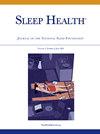Sleep duration associated with acute care utilization: Revisiting Andersen’s Behavioral Model of Health Services Use
IF 3.4
2区 医学
Q2 CLINICAL NEUROLOGY
引用次数: 0
Abstract
Objectives
Andersen’s Behavioral Model of Health Services Use explains healthcare utilization through three key domains—health needs, predisposing characteristics, and enabling resources—that influence whether individuals access medical care. This study examined whether self-reported sleep duration, as a health needs factor, is associated with acute care hospital utilization in the United States.
Methods
We analyzed data from 30,122 civilians ages 18+ from the 2020 National Health Interview Survey. Acute care utilization included past-year emergency room visits and overnight hospitalizations. Zero-inflated negative binomial and multivariable logistic regression models were used to assess associations of health needs, predisposing, and enabling factors with acute care utilization.
Results
Eight in 10 adults had no emergency room visits (81.1%), while 12.3% had one visit, 4.3% had two, 1.1% had three, 1.2% had 4+ visits, and 8.4% experienced overnight hospitalization. Sixty-four percent reported healthy sleep. Very short and long sleep were associated with significantly higher emergency room visit rates, while very short, short, and long sleep were associated with greater odds of overnight hospitalization compared with healthy sleep. Poor or fair health and multiple chronic conditions were also associated with increased acute care use. Predisposing (e.g., ages 18-44, female sex, Black race, and place of birth) and enabling factors (e.g., financial hardship, health insurance) further contributed to greater utilization.
Conclusions
Sleep duration is a significant and underexamined health needs factor in acute care utilization. Improving sleep health may help reduce the frequency of emergency room visits and hospitalizations. Future studies should explore the directionality of these associations and examine other sleep dimensions in relation to acute care utilization.
睡眠时间与急性护理利用的关系:重新审视安徒生的卫生服务使用行为模型。
目的:安徒生的健康服务使用行为模型通过三个关键领域——健康需求、倾向特征和使能资源——来解释医疗保健利用,这些领域影响个人是否获得医疗保健。这项研究调查了自我报告的睡眠时间,作为一个健康需求因素,是否与美国急症护理医院的使用率有关。方法:我们分析了来自2020年全国健康访谈调查的30122名18岁以上平民的数据。急性护理利用包括过去一年的急诊室就诊和过夜住院。使用零膨胀负二项和多变量logistic回归模型来评估健康需求、易感因素和使能因素与急性护理利用的关系。结果:8 / 10的成年人没有急诊室就诊(81.1%),12.3%的人有一次就诊,4.3%的人有两次就诊,1.1%的人有三次就诊,1.2%的人有4次以上就诊,8.4%的人住院过夜。64%的人表示睡眠健康。与健康睡眠相比,睡眠时间过短和过长与更高的急诊室就诊率相关,而睡眠时间过短、过短和过长与更大的过夜住院率相关。较差或一般的健康状况和多种慢性疾病也与急症护理使用的增加有关。易患因素(例如,18-44岁、女性、黑人种族和出生地)和有利因素(例如,经济困难、医疗保险)进一步促进了更高的利用率。结论:睡眠时间是急性护理利用中一个重要但未被充分研究的健康需求因素。改善睡眠健康可能有助于减少急诊室就诊和住院的频率。未来的研究应该探索这些关联的方向性,并检查其他睡眠维度与急性护理利用的关系。
本文章由计算机程序翻译,如有差异,请以英文原文为准。
求助全文
约1分钟内获得全文
求助全文
来源期刊

Sleep Health
CLINICAL NEUROLOGY-
CiteScore
6.30
自引率
9.80%
发文量
114
审稿时长
54 days
期刊介绍:
Sleep Health Journal of the National Sleep Foundation is a multidisciplinary journal that explores sleep''s role in population health and elucidates the social science perspective on sleep and health. Aligned with the National Sleep Foundation''s global authoritative, evidence-based voice for sleep health, the journal serves as the foremost publication for manuscripts that advance the sleep health of all members of society.The scope of the journal extends across diverse sleep-related fields, including anthropology, education, health services research, human development, international health, law, mental health, nursing, nutrition, psychology, public health, public policy, fatigue management, transportation, social work, and sociology. The journal welcomes original research articles, review articles, brief reports, special articles, letters to the editor, editorials, and commentaries.
 求助内容:
求助内容: 应助结果提醒方式:
应助结果提醒方式:


